
West Kalimantan is a province of Indonesia. It is one of five Indonesian provinces comprising Kalimantan, the Indonesian part of the island of Borneo. Its capital and largest city is Pontianak. It is bordered by East Kalimantan and Central Kalimantan to the east, the Malaysian state of Sarawak to the north, and the Bangka Belitung Islands to the west and the Java Sea to the south. The province has an area of 147,037 km2, and had a population of 4,395,983 at the 2010 Census and 5,414,390 at the 2020 Census; the official estimate as at mid 2023 was 5,623,328, and was projected to rise to 5,695,500 at mid 2024. Ethnic groups include the Dayak, Malay, Chinese, Javanese, Bugis, and Madurese. The borders of West Kalimantan roughly trace the mountain ranges surrounding the vast watershed of the Kapuas River, which drains most of the province. The province shares land borders with Central Kalimantan to the southeast, East Kalimantan to the east, and the Malaysian territory of Sarawak to the north.

East Kalimantan is a province of Indonesia. Its territory comprises the eastern portion of Borneo/Kalimantan. It had a population of about 3.03 million at the 2010 census, 3.42 million at the 2015 census, and 3.766 million at the 2020 census; the official estimate as at mid 2023 was 4,030,488. Its capital is the city of Samarinda.

Being an indigenous tribe in Borneo, the Kayan people are similar to their neighbours, the Kenyah tribe, with which they are grouped together with the Bahau people under the Apo Kayan people group. The Kayan people are categorised as a part of the Dayak people. They are distinct from, and not to be confused with, the Kayan people of Myanmar.
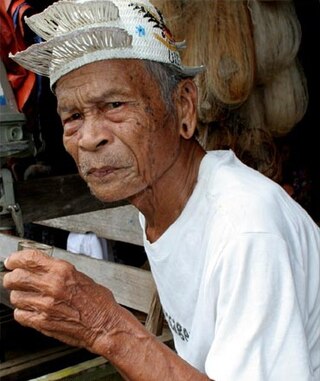
Punan Bah or Punan is an ethnic group found in Sarawak, Malaysia and Kalimantan, Indonesia. The Punan Bah people are distinct and unrelated to the semi-nomadic Penan people. Their name stems from two rivers along the banks of which they have been living since time immemorial. They have other names including Mikuang Bungulan or Mikuang and Aveang Buan but those are used only ritually nowadays.

Orang Ulu is an ethnic designation politically coined to group together roughly 27 very small but ethnically diverse tribal groups in northeastern Sarawak, Malaysia with populations ranging from less than 300 persons to over 25,000 persons. Orang Ulu is not a legal term, and no such racial group exists or is listed in the Malaysian Constitution. The term was popularised by the Orang Ulu National Association (OUNA), which was formed in 1969. Orang Ulu is totaling 180 000 people which is 6.2% from 2.8millions of Sarawak people.
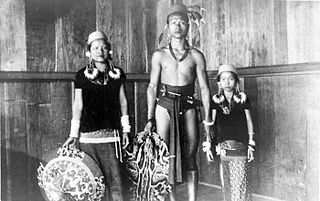
The Kenyah people are an indigenous, Austronesian-speaking people of Borneo, living in interior North and East Kalimantan, Indonesia and Sarawak, Malaysia.

Sendawar is the capital city of West Kutai Regency which is also the center of government and economy of West Kutai Regency.
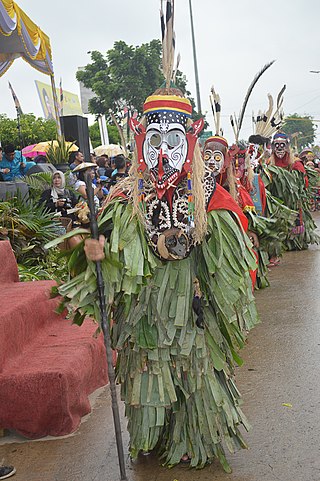
Hudoq is a masked dance performed during the Erau harvest thanksgiving festival by many of the sub-groups of the Dayak ethnic group in East Kalimantan province, Indonesia. The Hudoq culture and performance are indigenous to the Dayak population of East Kalimantan province, and they are said to have originated from Mahakam Ulu Regency.

Kutai is a historical region in what is now the Indonesian province of East Kalimantan on the island of Borneo. The region shares its name with the native ethnic group of the region, with a total population around 300,000, who have their own language known as the Kutainese language which accompanies their own rich history. Today, the name is preserved in the names of three regencies in East Kalimantan province which are the Kutai Kartanegara Regency, the West Kutai Regency and East Kutai Regency with the major river flowing in the heart of the region known as the Mahakam River. The Kutai Martadipura Kingdom (399–1635) was the earliest Hindu kingdom in the East Indies. It was later succeeded by the Muslim sultanate of Kutai Kartanegara (1300–1844).
The Kayanic or Kayan–Murik languages are a group of Austronesian languages spoken in Borneo by the Kayan, Morek Baram, Bahau, and related peoples.
The Melanau–Kajang languages or Central Sarawak languages are a group of languages spoken in Kalimantan, Indonesia and Sarawak, Malaysia by the Kenyah, Melanau and related peoples.
The Greater North Borneo languages are a proposed subgroup of the Austronesian language family. The subgroup historically covers languages that are spoken throughout much of Borneo and Sumatra, as well as parts of Java, and Mainland Southeast Asia. The Greater North Borneo hypothesis was first proposed by Robert Blust (2010) and further elaborated by Alexander Smith. The evidence presented for this proposal are solely lexical. Despite its name, this branch has been now widespread within the Maritime Southeast Asia region.
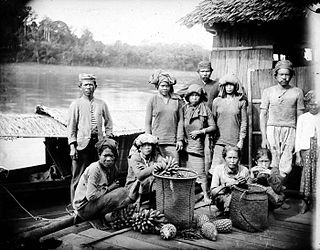
Bakumpai or Baraki are indigenous people of Borneo and are considered as a sub-ethnic group of the Dayak Ngaju people group with Islamic background. The Bakumpai people first occupy along the Barito riverbanks in South Kalimantan and Central Kalimantan, from Marabahan to Puruk Cahu, Murung Raya Regency. The Bakumpai people first appeared as a newly recognized people group in census 2000 and were made up of 7.51% of Central Kalimantan population, which before this the Bakumpai people were considered as part of the Dayak people in a 1930 census.

Sapeh, also spelled sape, sapeʼ, sapek, sapeik, sapeq, sampeh, sampeʼ, sampek, or sampeq is a traditional string instrument of Borneo-origin that developed in northern, eastern, and central regions of Sarawak and Kalimantan. It is a wooden-base instrument with strings attached, and works in a manner similar to the guitar.
Sarawak's population is very diverse, comprising many races and ethnic groups. Sarawak has more than 40 sub-ethnic groups, each with its own distinct language, culture and lifestyle. This makes Sarawak demography very distinct and unique compared to its Peninsular counterpart. However, it largely mirrors to other territories in Borneo – Sabah, Brunei and Kalimantan.
Kayan is a dialect cluster spoken by the Kayan people of Borneo. It is a cluster of closely related dialects with limited mutual intelligibility, and is itself part of the Kayan-Murik group of Austronesian languages.
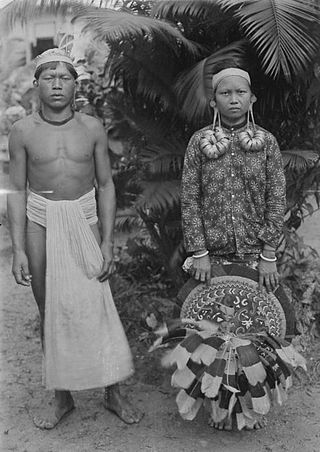
The Apo Kayan people are one of the Dayak people groups that are spread throughout Sarawak of Malaysia, North Kalimantan and East Kalimantan of Indonesia. The earliest Apo Kayan people are from the riverside of the Kayan River, Bulungan Regency, North Kalimantan, Indonesia. According to the Apo Kayan Dayak legend, the Kayan people are the forefathers of which all smaller sub-ethnic Dayak people that are found along the Kayan River came from. Today, the population of the Apo Kayan people are estimated about 64,900.

Putussibau is an Indonesian town in Kapuas Hulu Regency, West Kalimantan. It sits on the river Kapuas, with the main part of the town located on the right banks, or north, of the river. Officially an administrative village within North Putussibau District, the urban settlement sprawls outside of the primary boundaries to the opposite bank of the river. Official estimates from Statistics Indonesia places the population of the town proper at 12,459 in 2015.

The Special Region of Kutai was a regency-level special region within East Kalimantan, Indonesia, that existed from 1953 until 1960. Throughout its existence, it was led by the 19th sultan of Kutai, Aji Muhammad Parikesit, and its capital was located at Samarinda. It was formed on 7 January 1953 from earlier Kutai Self-Governance, and it was one of few second-level special regions to have existed in Indonesia, along with the Special Region of Berau and the Special Region of Bulongan.
Ujoh Bilang is a village within the district of Long Bagun, as well as the seat of Mahakam Ulu Regency, East Kalimantan, Indonesia. As of 2023, it was inhabited by 5,218 people, and currently has the total area of 354.73 km2. The majority of its inhabitants are Dayaks, with ethnic subgroups including Bahau Kayan and Kenyah.














